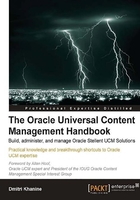
Standard metadata
Standard metadata is essential for the system to function. These are fields like content ID, revision ID, check-in date, and author. Let's take a quick look at all of them so you have a full picture.
Lab 2: Exploring standard metadata
Click on the Quick Search button on the top right. Yes, leave the search box blank. If you do that, you'll get all content in the repository.
In the last column on the Search Results page click on the i icon on any of the result rows. That brings up a Content Info screen.
From this screen there is no way to tell which fields are Standard and which are Extended. So how do you tell?
Explore the database
That's right. A Content Server uses a relational database, like Oracle or SQL Server to store its metadata, so let's look there.
If you followed my instructions in Chapter 2 and used SQL Server 2005 as your database, then open SQL Server Management Studio, and if not then bring up your SQL tool of choice.
Check the list of columns in the table called Revisions (as shown in the following screenshot):

Most of the column names in Revisions are the standard metadata fields.
Here's a list of the fields you will be using most often:
- dID: ID of the document revision. This number is globally unique. If you have a project plan with three revisions — each of the three will have unique dID and all of them will have the same Content ID.
- dDocName: this is the actual Content ID.
- dDocType: content type of the document.
Note
dDocName or Content ID is the unique identifier for a content revision set. dID is the unique identifier of each individual content revision within a set.
Being able to identify a content revision set is very useful, as it shows and tracks (makes auditable) the changes of content items over time.
Being able to identify each individual revision with dID is also very useful, so we can work with specific content revisions. This is one of the great advantages of the Content Server over other systems, which only store the changes between revisions. Full revision sets as well as individual revisions are managed objects and each one can be accessed by its own unique URL.
Now run this SQL statement:
select * from Revisions;
This shows the actual documents in the system and their values for standard meta fields (as shown in the following screenshot):

And now let's look at the all-important Content Types.